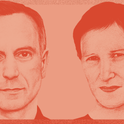A young Ukrainian in Kiev, on a march to celebrate the 104th anniversary of the birth of the anti-Soviet nationalist, Stepan Bandera. © AFP/Getty Images
History and Popular Memory: the Power of Story in Moments of Crisis by Paul A Cohen (Columbia, £24)
A nation is built on forgetting as much as on remembrance. So wrote the French historian and philosopher Ernest Renan, 130 years ago. For him, national unity was a precarious idea, a “daily plebiscite” that required that some memories—of shared suffering, shared heroes, shared myths—be continually renewed. Other, less useful memories—of civil wars, religious schisms, migrations, usurpations—needed to be repressed. One of the remarkable things about events in Ukraine since the start of the Euromaidan protests has been seeing this “daily plebiscite” play out in real time. In ways that can be hard for outsiders to register, much of the conflict in Ukraine is expressed in historical terms. For the participants in the political struggle the choice of symbols, heroes and predecessors is particularly fraught. Ukraine has more than one history. Its life as a state has been brief. Aside from the last 20 years, its main periods of independence are a stretch in the 17th century and moments, some as short as a day, during the First and Second World Wars. In western Ukraine, national identity was formed in reaction to the domination by the Polish-Lithuanian commonwealth and Austro-Hungarian empire; in the east, by long co-existence with the Russian empire. The novelist Serhiy Zhadan has explained the tensions between east and west in terms of rival commemorations of 20th century figures: “There will be no mutual understanding while the east erects monuments to Stalin and the west to Shukhevych,” the leader of the Nazi-allied Ukrainian Insurgent Army. Because of this diversity of experience, it’s hard to find figures or movements that suit the needs of the current political crisis. Stepan Bandera, for instance, whose right-wing admirers played a major part in the Euromaidan protests, had the right enemy but the wrong allies. Bandera fought against the Soviet Union for freedom—but at the side of the Nazis. His movement is an inspiration for Svoboda, one of the most prominent far-right political parties in Ukraine. But during the protests, the Banderaist chant “Glory to Ukraine! To heroes glory!” spread far beyond his immediate followers, taken up by many protesters who have no allegiance to his exclusionary brand of nationalism. The problem of finding a suitable past is not peculiar to Ukraine. In Northern Ireland and Scotland, the legacies of the Battle of the Boyne and the Highland Clearances are still bitterly contested, while in the United States a host of issues—from the faith of the founding fathers to the causes of the Civil War—remain subject to angry debate. But while many countries go through the processes of editing their histories, it normally takes centuries, not weeks, as it has in Ukraine. In light of this year’s events, Paul A Cohen’s new book, History and Popular Memory: the Power of Story in Moments of Crisis, seems especially timely. Cohen’s main argument is admirably simple: at certain junctures in history, particularly in moments of crisis, a country will reach back in time for a story from its past that serves as a useful metaphor for the present. In the process, the original story undergoes a degree of reshaping. Over time, the original story gains so many additions and adumbrations that it barely resembles the animating event. Cohen presents five case studies to demonstrate the different ways in which historical events have been tailored to fit political and symbolic needs. In each chapter he presents a legend, the historical truth behind it and the story of how the gap between the legend and the truth evolved. Some of his examples are familiar but for each one Cohen manages to reveal unexpected details about the passage from history to myth. For instance, the legend of Joan of Arc has undergone countless transformations. The girl from Lorraine has been made into every- thing from a Catholic saint to proto-feminist icon to an expressionist martyr. Cohen focuses his chapter on Joan on the uses her legend was put to during the Second World War. For Charles de Gaulle, she was a symbol of national unity and implacable resistance against an overwhelming foe. But for Vichy propagandists she was a “typical French girl” who “loved beautiful clothes,” preferred her banner to her sword, and could “outsew any woman in Rouen.” The Second World War reappears as the motivating crisis for historical appropriation in Cohen’s chapter on the classic movies Alexander Nevsky and Henry V. However, between the needs of propaganda and the demands of dramaturgy, the two films drift rather far from what could accurately be called popular memory. Cohen’s chapter on Masada does a much better job of tracking the ebb and flow of remembrance across the centuries. The story of the Sicarii, the Jewish rebels who committed mass suicide on a hilltop fortress rather than surrender to the Romans, was first told in antiquity. But for almost 2,000 years, the site of the event, Masada, barely featured as a part of Jewish memory. It was revived only in the 1920s, by Yitzhak Lamdan, a Hebrew-language poet writing in British Palestine. Lamdan’s 1927 poem “Masada” became a literary sensation upon its publication and was quickly incorporated into Hebrew school curricula. “Masada” wasn’t the triumphalist call to battle one might expect. Lamdan was born in Ukraine and had fought in the Red Army during the revolution. The poem is deeply ambivalent about his new home. Cohen describes its tone as “apocalyptic.” It captured Jewish settlers’ sense of isolation and despair, the fear that they might have doomed themselves to self-destruction in a foreign land. Lamdan’s poem became popular because, and not in spite of, its pessimism. But after Israeli independence the meaning of Masada underwent a dramatic shift. The desert fortress became the site of a nationwide cult. Its very shape—an isolated plateau, surrounded by cliffs on all sides, like a stone aircraft carrier—seemed to symbolise the situation of the embattled country, surrounded by its enemies. Hundreds of thousands of soldiers trekked to its summit. Members of the Israel Defence Force’s armoured units even took their oath of allegiance there at the completion of their training. During excavations in the 1960s, archaeologists found 27 skeletons of the Sicarii. These were given an elaborate state funeral with full military honours. And then, quite suddenly, the myth began to fade. Military victory in the Six-Day War drained it of some of its relevance and the example of the “Zealot-Sicarii fanatics” started to seem more frightening than admirable. High school trips to Masada are no longer mandatory and the army has stopped performing ceremonies at the fortress (although the site is still a part of Israeli outreach to the Jewish diaspora, as through the sponsored tours of “Birthright,” which bring young Jews from around the world to visit Israel). Now, though, the pendulum may have swung the other way, as Masada has gained new significance for a growing number of religious Zionists, for whom it is a symbol of “dying in the name of God.” Of all Cohen’s examples, the historical myth of the Battle of Kosovo may have held the strongest—and most destructive—hold on its audience. Kosovo, the “Field of Blackbirds” where the Serbian nobility suffered a crushing defeat at the hands of the Ottoman Turks in 1389, in a battle that opened the door to the kingdom’s full annexation, has an outsized place in Serbian national consciousness. But as Cohen shows, although based on a real military encounter between a confederation of Christian Balkan lords and the army of the Sultan Murad I, the legend transmitted in Serbia departs from the historical record in a number of ways. The story passed down in folktales and songs amounts to a passion play. In it, the Serbian lord, Prince Lazar, decides that it is better to die by a heroic act than to live in shame. In a feast on the eve of the battle, Lazar says that one of his knights, Miloš Obilic, will desert him and go over to the Sultan’s side. Obilic protests, and identifies the real traitor, Vuk Brankovic. The next day, Obilic proves his loyalty, sneaking into the Sultan’s tent and killing him, while Brankovic goes over to the enemy side, revealing himself to be the true Judas. Even before the Ottoman conquest was completed in 1459, the story of the Battle of Kosovo became a pivotal feature of Serbian culture. Prince Lazar was made a saint of the Orthodox Church. In the 19th century the story was a cornerstone of the nation’s literary revival. From a parable about the importance of faith and the duty of a vassal to his lord, the battle was gradually made into the single greatest calamity in Serbian history. The story fed a sense of Serbia as a martyred nation surrounded by enemies, both internal and external, which would one day win back “with the sword” what “was lost with the sword.” In this way, Kosovo, the province surrounding the battlefield, became a holy ground for Serbian nationalists. In the 20th century the battle was invoked in every moment of crisis, from the 1912-13 Balkan Wars to the break-up of Yugoslavia in the 1990s. The commemoration of its 600th anniversary helped launch the post-communist career of Slobodan Miloševic. It was there that he discovered his abilities as a populist rabble-rouser, and how effective stirring ethnic tensions could be in cementing his rule. In 1999, when Miloševic began his campaign of ethnic cleansing against the Kosovar Albanians, he could claim to be avenging the wrongs inflicted by the Turks centuries before. The legend of the Battle of Kosovo may be the strongest example of the power of myth to sway a people. So much so, in fact, that it overpowers Cohen’s rather modest thesis. Instead of a country reaching back for a story in time of crisis, the Battle of Kosovo seems to be a case of a story continually producing crises of its own. And it’s a story that belongs to more than one people, with different meanings for different audiences. For Cohen, nations cohere around memory. But memories can attach themselves to multiple nations. Cohen doesn’t mention it, but Albanians have their own story of Kosovo, which means nearly the opposite of what it does to the Serbs. In the Albanian story, passed down through the generations by bards, the Albanians fight alongside the Serbs against the Ottomans. In this version, Obilic the assassin was actually named Kopiliq, and he was an Albanian instead of a Serb. Kopiliq was a trickster with supernatural strength. After he stabs the sultan he is beheaded, but he doesn’t die. Instead he rides home on a white steed with his severed head under his arm. He doesn’t stop until a girl sees him and asks her father where the brave man without a head is going. For Albanians in Kosovo, Kopiliq’s existence confirms their right to their land and their membership in Europe as defenders of Christendom. Since the Kosovo war of the late 1990s, the myth of Kopiliq has gained in strength, and Albanian historians have done their best to write him into national history as a real rather than a legendary figure. (In fact, the earliest mentions of Kopiliq/Obilic do not appear until the 1480s, a century after the battle.) Tailored to fit local needs, the phantom assassin has taken on a reality of his own. Anna Di Lellio, a student of Albanian versions of the Kosovo story, describes talking with a former Kosovo Liberation Army fighter who shows her, with unwavering certainty, the exact place where the headless Kopiliq ran away from the Ottoman soldiers. Kosovo gave birth to a number of stories; Ukraine searches for one to hold it together. Cohen’s book suggests that popular memory and myth-making will have a greater role in this than rigorous historical scholarship. But it’s equally possible that finding a usable past for Ukraine will depend on a good deal of mis-remembering. A detailed memory for past crimes may be no substitute for a dose of benevolent fiction.

A young Ukrainian in Kiev, on a march to celebrate the 104th anniversary of the birth of the anti-Soviet nationalist, Stepan Bandera. © AFP/Getty Images
The memory wars
History is re-told to fit the needs of the present, but these distortions create violent conflicts of their own
July 17, 2014











